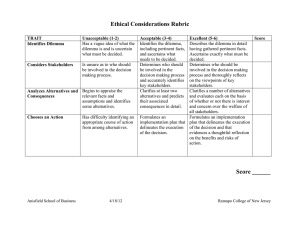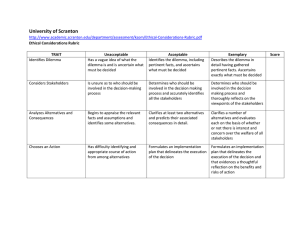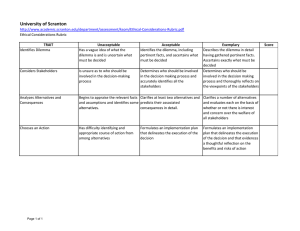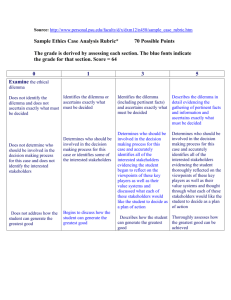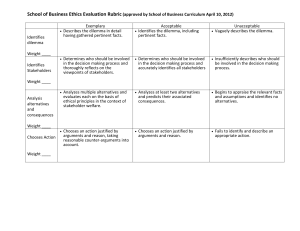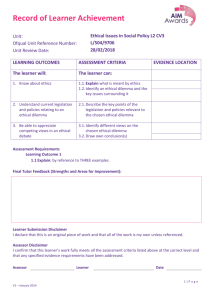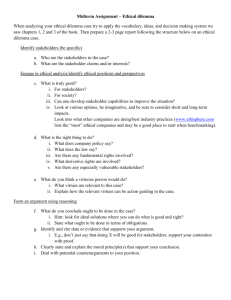Case Study, Ethics
advertisement
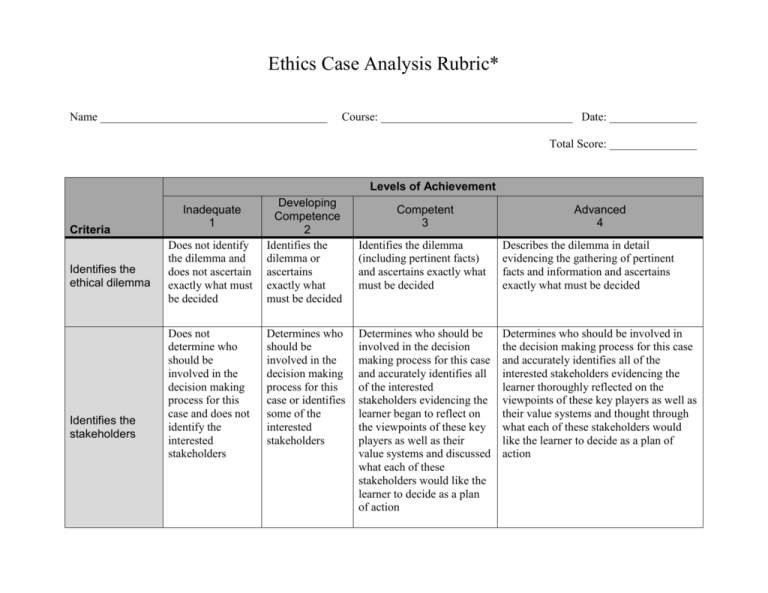
Ethics Case Analysis Rubric* Name _______________________________________ Course: _________________________________ Date: _______________ Total Score: _______________ Levels of Achievement Criteria Identifies the ethical dilemma Identifies the stakeholders Inadequate 1 Does not identify the dilemma and does not ascertain exactly what must be decided Does not determine who should be involved in the decision making process for this case and does not identify the interested stakeholders Developing Competence 2 Identifies the dilemma or ascertains exactly what must be decided Determines who should be involved in the decision making process for this case or identifies some of the interested stakeholders Competent 3 Advanced 4 Identifies the dilemma (including pertinent facts) and ascertains exactly what must be decided Describes the dilemma in detail evidencing the gathering of pertinent facts and information and ascertains exactly what must be decided Determines who should be involved in the decision making process for this case and accurately identifies all of the interested stakeholders evidencing the learner began to reflect on the viewpoints of these key players as well as their value systems and discussed what each of these stakeholders would like the learner to decide as a plan of action Determines who should be involved in the decision making process for this case and accurately identifies all of the interested stakeholders evidencing the learner thoroughly reflected on the viewpoints of these key players as well as their value systems and thought through what each of these stakeholders would like the learner to decide as a plan of action Levels of Achievement Criteria Inadequate 1 Does not delineate any alternatives Does not clarify consequences Identifies Alternatives Does not give evidence that the learner reflected on any of the alternatives Compares and evaluates the ethical arguments Does not rate the ethical reasoning and arguments for each alternative Does not refer to their professional codes of ethical conduct. Developing Competence 2 Delineates 1 alternative Clarifies one alternative and predicts the associated consequences in detail Begins to appraise the relevant facts and assumptions Rates the ethical reasoning and arguments for some of the alternatives Provides evidence that the learner began to reflect on the alternatives Begins to refer to their professional codes of ethical conduct. Competent 3 Advanced 4 Delineates 2 alternatives Delineates more than 2 possible alternatives Clarifies at least one Clarifies all identified alternatives and alternative and predicts the predicts their associated consequences in associated consequences in detail detail Appraises the relevant facts and assumptions; noting the evaluation of any ambiguous information Appraises relevant facts and assumptions; noting the evaluation of any ambiguous information and explores any unjustifiable factual or illogical assumptions, or debatable conceptual issues Rates the ethical reasoning and arguments for most of the alternatives. Rates the ethical reasoning and arguments for all of the alternatives Provides evidence of systematic reflection on the alternatives through evaluating each alternative’s impact on key players. Provides evidence of systematic reflection on the alternatives through evaluating each alternative’s impact on key players and determines which alternative will provide the greatest good or least amount of harm. Refers to their professional Refers to their professional codes of codes of ethical conduct ethical conduct and determines if it supports their reasoning Levels of Achievement Criteria Chooses a recommended alternative Formulates an implementation plan Inadequate 1 Does not make a decision about the best alternative available Does not formulate an implementation plan Does not problem solve or use Problem critical thinking Solving, decision-making, skills and critical Has difficulty thinking skills making decisions Developing Competence 2 Determines the best alternative available Competent 3 Advanced 4 Determines the best alternative available and describes how their decision maximizes the benefit and minimizes the risk for everyone involved Determines the best alternative available, describes how their decision maximizes the benefit and minimizes the risk for everyone involved, and they challenge their decision as they think others might, and defend it by from the ethical arguments they predict others would use Begins to formulate an implementation plan Formulates an implementation plan that delineates the execution of the decision Formulates an implementation plan that delineates the execution of the decision and evidences a design that will maximize the benefits and minimize the risks while taking into account all of the resources necessary for implementation including personnel and money Evidences the beginning of problem solving and critical thinking Uses problem solving and Uses problem solving and critical critical thinking skills during thinking skills throughout the entire case analysis case analysis Is able to make major decisions Is able to make major decisions with rationale Is able to make minor decisions. Adapted from http://www.personal.psu.edu/faculty/d/x/dxm12/n458/sample_case_rubric.htm *Based on the Ethical Model for Ethical Decision Making developed and owned by Educational Advancement Associates.
